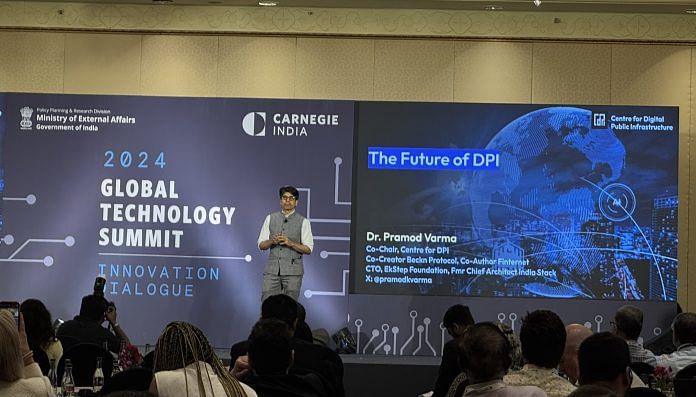AI chatbots are now directly assisting farmers in Haryana. Whether they need help applying for pensions or restarting government-assisted payments that abruptly stopped, Jugalbandi—a new generative, Indian government-backed AI-driven chatbot available on mobile devices—has become their go-to resource. It provides instant answers, eliminating the need to wait in long queues at local service centres.
This was one of many examples of AI-driven welfare initiatives highlighted at the two-day Global Technology Summit Innovation Dialogue, organised by Carnegie India and the Ministry of External Affairs at Bengaluru’s Leela Palace from October 8-9.
Leading researchers and industry experts, including Pramod Varma and Ramesh Ragineni, participated in the dialogue, discussing how AI technologies can promote inclusive growth and improve governance while also addressing ethical challenges. Government officials from India, the United States, Papua New Guinea, and other Quad countries were present at the event, elaborating on how technology can be used to deliver essential services to citizens.
“While all technology is disruptive, we must harness it with a solution-based approach and focus on solving societal problems,” said Seth Center, acting special envoy for critical and emerging technology at the US Department of State. “This is one area where the world should learn from India,” he added.
Also read: India needs National Technology Coordinator. An Indian model in digital infrastructure is ready
India and its digital identity
During the discussions, representatives from several countries recognised India’s strides in developing its Digital Public Infrastructure (DPI).
Center recalled a “Peak Bengaluru” moment from social media. “There was a picture online of a help desk at a Bengaluru hotel being empty. A virtual receptionist was instead managing all guest services remotely…Many online said this was peak Bengaluru,” he said, adding, “But I think Bengaluru has higher peaks it will reach soon.”
India’s tryst with DPI began with Aadhaar, the digital identity programme launched in 2009.
“There was no single language that bound all 1.4 billion people in the country. This diversity necessitated India to look at a slightly different way to create [a] non-uniform but unified infrastructure for inclusion,” explained Verma, the chief architect of Aadhaar.
Access to this digital ID means access to digital healthcare services, cashless transactions (UPI), and other essential government services.
“India’s digital identity grew from zero to a billion,” Verma added. He expects that DPI will continue to disrupt sectors such as credit systems, logistics, and e-commerce (ONDC).
Noting this progress, Periasamy Kumaran, special secretary at the MEA, said that India is committed to helping other nations adopt and scale DPI platforms through technology transfer and the promotion of open-source technologies.
“We can encourage partnerships between India’s digital startup ecosystem and entrepreneurs from the Global South to co-create DPI solutions. This could include accelerators, incubators, and collaborative funding mechanisms,” Kumaran said.
Also read: US-China tech rivalry will have spillover effects. India must hedge itself
Risks and challenges
Panellists in the discussion titled ‘Open-Source AI for Global South’ acknowledged the potential risks of using AI technology for citizen-related services, such as its possible misuse for crime and warfare, and the challenges of delivering services in one of the most populous countries in the world.
“Indian enterprises deal with over a million people over a day. Many of their end customers do not speak just English,” said Karn, co-creator of Jugalbandi.ai, during the discussion.
Reiterating the need for multilingual models, he explained how the Jugalbandi chatbot can understand questions in multiple languages, whether spoken or typed. Although this chatbot is only a year old, Karn said that it would soon provide all Indians easy access to information in their local language through mobile phones.
“Such models would have a huge impact on the lives of a lot of people in India who still survive on welfare, and whose real potential is yet to be unlocked,” Karn said. He shared that early tests with female domestic workers in Bengaluru showed high levels of comfort and satisfaction with the AI tool. “Without it, they would have to rely on their husbands or children to understand that there are some government schemes they are eligible for,” Karn observed.
Similarly, another multilingual model mentioned during the discussion was Bengaluru-based Sarvam AI, founded in 2023 and recognised in tech circles as the country’s torchbearer in generative AI. The startup’s voice-based agents, currently being evaluated by major Indian companies, communicate with customers in at least 10 local languages, plus English, through phone calls, WhatsApp, or in-app chats.
With more AI technology-led initiatives expected in the future, countries in the West are eagerly observing India’s progress.
“Bengaluru is referred to as the Silicon Valley of India. But the ambition is that Silicon Valley would be the Bengaluru of the West Coast of the United States,” said Center.
(Edited by Prashant)




